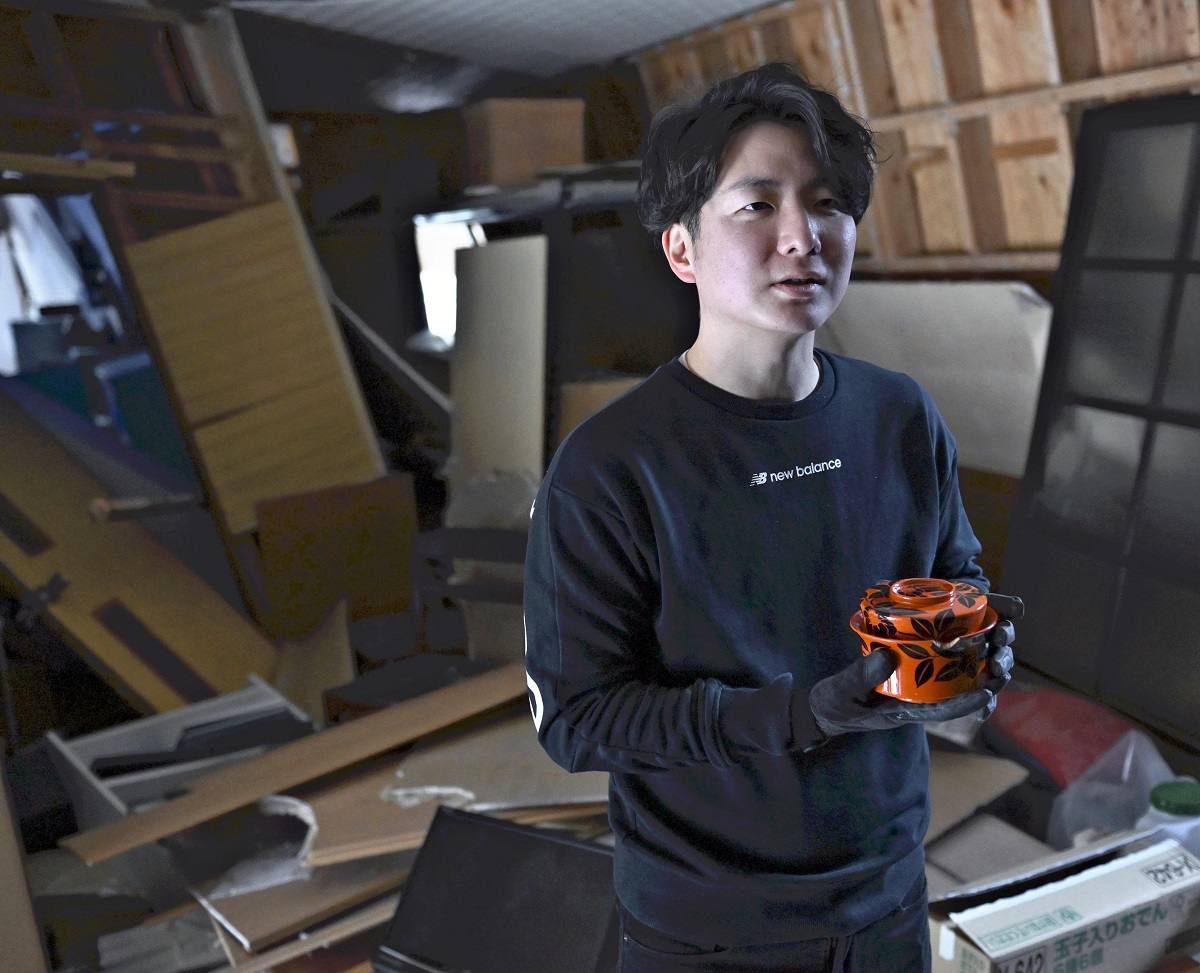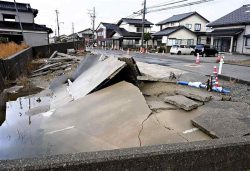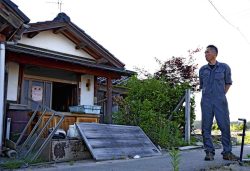Noto Quake Deals Heavy Blow to Wajima Lacquerware Craft; 80% of Workshops Said Damaged of Destroyed

A man holds partially cracked Wajima-nuri ware damaged by the quake in Wajima, Ishikawa
18:22 JST, January 27, 2024
In the recent series of quakes that hit the Noto Peninsula, a majority of the workshops and sales establishments of Wajima lacquerware were heavily damaged, including by collapse and burning.
The lacquerware craft, known as Wajima-nuri in Japanese, is nationally recognized as an important intangible cultural asset.
Wajima lacquerware workshops were also hit hard during the 2007 earthquake and had just been rebuilt.
Wajima-nuri is a traditional craft that represents Japan’s lacquer culture and is considered one of the Noto region’s major tourism resources. The government plans to swiftly consider extending comprehensive support measures for the rebuilding of this craftwork business.
Wajima lacquerware is characterized by a sophisticated technique involving the careful application of a lacquer undercoat to wooden bowls, trays and stackable boxes. A key ingredient in this undercoat is a high-quality powder called jinoko, made with powdered diatomaceous soil found in Wajima.
Artisans then apply decorative techniques to create graceful designs using gold or silver dust. One method, called chinkin (inlaid gold), adds inlaid gold to a design carved into the lacquered surface. Another, maki-e (sprinkled gold), involves drawing pictures and patterns on the surface.
Production of Wajima lacquerware is said to have begun during the Muromachi period (1336-1573). In recognition of its high artistic value, it was officially registered as a “traditional craft” by the national government in 1975. In 1977, Wajima became the first production area to have its lacquerware recognized as an important intangible cultural property.
There are estimated to be about 1,000 people engaged in this traditional craftwork, including sole proprietorships. The workshops and business establishments have been concentrated in the urban district of Wajima, Ishikawa Prefecture.
According to the lacquerware promotion strategy office of the Wajima city government, 70% to 80% of those engaged in lacquerware-related businesses are seen to have suffered damage, including the collapses of workshops where proprietors also live.
According to the local lacquerware manufacturers cooperative association, the offices and stores of at least 15 of its 103 member business operators were destroyed by the earthquake-triggered major fire that occurred in the Asaichi-dori morning market area in Wajima.
In addition, several business establishments, including that of Goshimaya Co., a major lacquerware manufacturer and seller, were either damaged or destroyed. The secretary general of the association, said, “The full extent of the damage is still unknown.”
Three craftsmen who live in Wajima and whose Wajima-nuri skills earned them government recognition as living national treasures — or holders of important cultural property — were affected by the quakes. One of them is Kazuo Yamagishi, 69, for the genre of chinkin. He broke his left shoulder in the disaster.
The Ishikawa Prefectural Wajima Institute of Lacquer Arts, a center for passing down the techniques of Wajima lacquerware, has been closed due to the water supply cutoff caused by the earthquake and aftershocks.
The Wajima lacquerware industry suffered damage during a massive earthquake in 2007, too. According to the city government, 85 buildings of relevant business operators were destroyed or partially damaged then.
This time, however, the scale of the fire around Asaichi-dori Street and the collapse of buildings throughout the entire city area was so large that an official of the municipal government said, “The latest damage cannot compare with the previous case.”
Wajima lacquerware had its heyday during the period of the asset price bubble in the late 1980s. But sales have declined since then, due to factors such as changing lifestyles. Production in fiscal 2022 was approximately ¥2.4 billion — less than one-seventh of its peak.
The aging of craftsmen is accelerating amid a shortage of successors, and two-thirds of those engaged in the craftwork are now 60 or older. The production process has more than 100 steps, and there is a division of labor among highly specialized craftsmen. The continued existence of this craftwork is in jeopardy.
As part of measures the government announced on Thursday to support those affected by the latest quakes, the Economy, Trade and Industry Ministry has spelled out a plan to subsidize traditional craftworks in the region, including Wajima-nuri, by providing up to ¥10 million to cover three-fourths of the cost of continuing a relevant business.
To carry on one of the excellent brands this country is proud of, the government is considering further support.
Tokugo Uchida, executive director of the MOA Museum of Art, who is knowledgeable about lacquerware, said: “Japan’s lacquerware culture could be in danger of extinction. It is ncessary to consider support and reconstruction in a grand framework.”
"Society" POPULAR ARTICLE
-

M4.9 Earthquake Hits Tokyo, Neighboring Prefectures
-

M7.5 Earthquake Hits Northern Japan; Tsunami Waves Observed in Hokkaido, Aomori and Iwate Prefectures
-

Tsukiji Market Urges Tourists to Avoid Visiting in Year-End
-

Israeli Tourists Refused Accommodation at Hotel in Japan’s Nagano Pref., Prompting Protest by Israeli Embassy and Probe by Prefecture
-

M5.7 Earthquake Hits Japan’s Kumamoto Pref., Measuring Upper 5 Intensity, No Tsunami Expected
JN ACCESS RANKING
-

Keidanren Chairman Yoshinobu Tsutsui Visits Kashiwazaki-Kariwa Nuclear Power Plant; Inspects New Emergency Safety System
-

Imports of Rare Earths from China Facing Delays, May Be Caused by Deterioration of Japan-China Relations
-

University of Tokyo Professor Discusses Japanese Economic Security in Interview Ahead of Forum
-

Japan Pulls out of Vietnam Nuclear Project, Complicating Hanoi’s Power Plans
-

Govt Aims to Expand NISA Program Lineup, Abolish Age Restriction
























